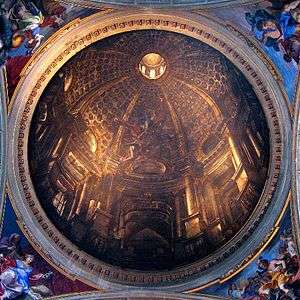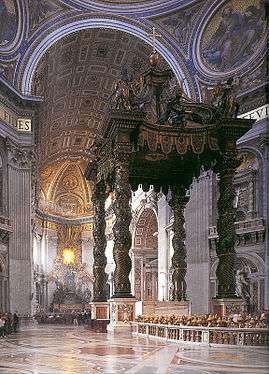Italian Baroque interior design
Italian Baroque interior design refers to high-style furnishing and interior decorating carried out in Italy during the Baroque period, which lasted from the early 17th to the mid-18th century. In provincial areas, Baroque forms such as the clothes-press or armadio continued to be made into the 19th century.
History, influences and background
In the late 16th century, Rome was the seat of an extremely powerful and influential papacy which were struggling with the advent of Protestantism.[1] As a response to the Protestant Reformation, the Curia started the Counter-Reformation, (after the Council of Trent), a period in which the church's policies and influence abroad would be strengthened. Due to this Catholic Reformation, popes in Rome hired several architects, painters and interior designers to re-decorate the city and improve its public decorum,[1] creating several new palaces and churches, and re-designing the interiors of several papal buildings. Decorations were richer and more grandiose than those of the Renaissance, and this movement evolved into the Baroque, which later spread across the whole of Italy and later Europe.
To accord with these new architectural styles, new furnishing styles also emerged, for which architects even as pre-eminent as Bernini,[2] were called upon to provide designs. In his Opus architectonicum Borromini fully described the furniture he designed for the Chiesa Nova, including the reused priests' bookcases, and Carlo Fontana was called upon shortly after 1692 to design the support for a porphyry tavola, or table-slab, for the bapistry of St Peter's; it was enriched with bronze ornaments and the Pignatelli arms of Pope Innocent XI.[3] Architects had been called upon since the days of Buontalenti to design such marble or pietra dura tables on bases for the centers of grand spaces.
Since this was an age where learning and patronage of the arts were considered desirable pursuits for nobles, the bookcase came out of the private studiolo to furnish state apartments as an object of display. Among new forms of furniture in parade apartments, free-standing bookcases were no longer built into the structure of rooms. Lavish bookcases started to be made, often with gilded marble columns and intricate designs.
Roman carvers' shops outshone the more modest craft of cabinetmaking, as demanding commissions overseen by architects for carved decors, frames, altar candlestands, confessionals and pulpits came in a steady stream for the furnishings of churches and semi-public chapels. In secular apartments of parade, richly carved, painted and gilded frames came from the same shops. Carved frames and case furniture had come to rival the former primacy of textiles during the course of the 16th century. Baroque objects were grand in scale in proportion to the interiors they occupied, and would be ornamented with cartouches, swags and drops of boldly scaled fruits and flowers, open scrollwork and carvings of human figures, which swarmed over and all but effaced the tectonic forms that supported them which made them look majestic and royal in appearance.[1]
The frescoed galleries of the city's many palazzi were lined with elaborate console tables set against the piers and between the windows. In ceilings the new popular style of frescoing emerged known as the quadratura from its elaborate framing, was reflected in the framing of large looking-glasses, assembled fromsix to eighteen panes of Venetian mirror-glass, themselves being made in larger dimensions than ever.
In Florence, grand cabinets known as stippone (plural:stipponi) began to be produced in the ducal workshops, thought to have been inspired from Augsburg cabinets.[1] They had many shells and carved foliages, and were decorated with expensive materials, such as gilt bronze, ebony and pietra dura. Around 1667, Leonardo van der Vinne, a well-known cabinet maker from the Low Countries became part of the ducal workshops.
In Genoa, grand console tables supporting huge marble slabs on carved gilt bases began to be made.[1] The offer of an armchair continued to convey elite status: inventories record a single one or a pair in rooms where the seating otherwise was on armless side-chairs, sgabelli of traditional construction— now enriched with bold sculpture— and stools. Chairs made by the Genoese were made with rich fabrics, often silk or velvet, to accord with the hangings and were often gilded with gold or silver.[1]
After the mid-17th century, the state bed also came to provide the expected climax of the sequence of rooms in a Baroque apartment, following precedents established in France. Late-17th century Italian beds were usually grand in scale, often with elaborate wooden backs and fabric drapes. They were usually similar in style throughout the nation, but the textiles varied by region.[4]
Italian baroque furnishing also had considerable Eastern influences.[4] Venetians, who at the time still held a vast sea empire, often imported rich fabrics and materials from other nations to enrich their furniture with some eastern influences. Their furniture was mainly sumptuous and luxurious, and included rich silks and green and gold lacquer.[4]
However, in Italy, there were considerable differences in the interior design of a grand palazzo than that of a normal house. Palazzi were usually lavish and sumptuous, whilst middle-class town/country houses were usually far plainer, with simple wooden beds, x-framed chairs and big cassoni, or chests.[4]
Different sorts of furnishings
Gilded frames
Gilded frames were very frequently used in paintings and mirrors,[1] and usually consisted of several cartouches, carved flowers and sculptural figures.
Cassoni
A cassone is an Italian chest; cassoni usually had a raised lid, often decorated with carved leaves and/or figures.[1] Cassoni found in rich people's houses were usually far more grand and elaborate, even though they were nearly always wooden,[1] however more middle-class families' chests were simpler and still retained some Mannerist/Renaissance features, such as paw feet, strapwork and segmented panels.[1]
(Florentine) Console tables
Florentine Console tables were often richly decorated and sumptuous.[4] The carved wood was often gilded in gold or bronze,[4] and the table legs were mainly caryatids or muscular figures, made to look as if they were holding the marble slab on top. Most of their themes were copied or nearly identical to their Roman counterparts, but the Florentines became famous for these designs.
(Florentine) Cabinet
Florentine cabinets were usually very similar to those of the Renaissance in essence, except a few changes. Segments and strapwork was still used, however, it was also included new features such as pilasters, arched panels and pietra dura designs. Often religious or mythological themes were drawn inside the panels to add decoration to the object.
Lion Commode
Lion commodes were often made of walnut or oak,[4] pearl, jewels and ivory, which made fantastical and allegorical designs. They were often decorated with angels, animals, leaves, saints and flowers. They were called lion commodes specifically due to their lion-shaped feet at the bottom of the drawer.[4]
Tables
Tables varied greatly during the Baroque period, but were often made of gilded wood, oak or walnut. Large tables were long, rich and sumptuous, whilst smaller ones were usually ornate and geometric.
Quadratura

Quadratura, a term which was introduced in the 17th century and is also normally used in English, became popular with Baroque artists. Although it can also refer to the "opening up" of walls through architectural illusion, the term is most-commonly associated with Italian ceiling painting. Unlike other trompe-l'oeil techniques or precedent di sotto in sù ceiling decorations, which often rely on intuitive artistic approaches to deception, quadratura is directly tied to 17th-century theories of perspective and the representation of architectural space.[5] Due to its reliance on perspective theory, it more fully unites architecture, painting and sculpture and gives a more overwhelming impression of illusionism than earlier examples.
The artist would paint a feigned architecture in perspective on a flat or barrel-vaulted ceiling in such a way that it seems to continue the existing architecture. The perspective of this illusion is centered towards one focal point. The steep foreshortening of the figures, the painted walls and pillars, creates an illusion of deep recession, heavenly sphere or even an open sky. Paintings on ceilings could, for example, simulate statues in niches or openings revealing the sky.
Quadratura may also employ other illusionistic painting techniques, such as anamorphosis.
Examples of illusionistic painting include:
- Andrea Pozzo at San Ignazio in Rome and the Jesuit church in Vienna. He wrote the standard theoretical work of his artistic ideas in the two volumes of : Perspectiva pictorum et architectorum Andreae Putei a societate Jesu (Rome, 1693–1700).
- Pietro da Cortona at the Palazzo Barberini,
- Gianbattista Tiepolo in the Ca' Rezzonico in Venice, Villa Pisani at Stra, and the throne room at the Royal Palace of Madrid.
Other examples were by Paolo Veronese at Villa Rotonda in Vicenza and Baldassare Peruzzi in the Villa Farnesina of Rome.
Gallery
-
The Baroque interior of the Palazzo Corsini, in Florence
-
A Baroque altar in the Church of Santa Maria Maddalena in Florence
-

The Baroque staircase in the Palace of Caserta
-

The Baroque Basilica della Santissima Annunziata del Vastato in Genoa
-

The Baroque Baldacchino in St Peter's Basilica, Rome
-
Santa Maria sopra Minerva Church in Assisi's Baroque altar
-
The staircase of the Baroque Palazzo Madama, Turin
-
The Chapel of the Royal Palace of Naples
See also
References
- 1 2 3 4 5 6 7 8 9 10 Miller (2005) p.40
- ↑ Alvar Gonzalez-Palacios, "Bernini as a furniture designer" The Burlington Magazine 112 No. 812 (November 1970):719-723).
- ↑ Ugo Donati, Artisti ticinesi a Roma, (Rome) 1942, fig. 253.
- 1 2 3 4 5 6 7 8 Miller (2005) p.41
- ↑ Rudolf Wittkower, Joseph Connors and Jennifer Montagu, Art and Architecture in Italy, 1600–1750, vol. 1, Pelican history of art, New Haven: Yale University Press (1999): 35-36.
Bibliography
- Miller, Judith (2005). Furniture: world styles from classical to contemporary. DK Publishing. ISBN 0-7566-1340-X.